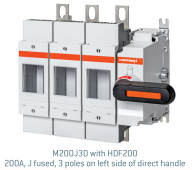I was wondering about that - it did say 'low voltage' but didn't mention DC anywhere.
Having said that, I have to presume that there are DC fusible disconnects for DIN rail out there somewhere. Any recommendations?
"Low Voltage" to industry is < 600VAC

With the compact size of DIN rail components, I haven't seen fuse holder and disconnect in one.
What I do see are multiple switches or breakers ganged in parallel, or interlocked as a transfer switch.
And multiple fuses or breakers with a tiebar so they connect in parallel to a lug for single wire out.
Interrupting DC is more difficult than AC, because the arc continues to flow instead of current dropping to zero every 0.008 seconds.
Many DC breakers are polarized - they have a permanent magnet to deflect arc and help interrupt it, but they only work for current flowing in one direction. Some are DC rated and unpolarized; I think they have a coil of wire to make an electromagnet with its poles in the correct orientation whichever direction current flows.
In PV and battery applications, often bidirectional current is possible. You want current to flow one direction and be interrupted when you turn off the breaker. But if the hardware gets a short circuit, current from battery (or other PV panels in parallel) can dump current in the opposite direction. So I think you have to be careful using polarized breakers, and I don't trust all the configurations recommended by manufacturers.
Using fuses to protect against over-current and a breaker of higher current rating, which you open manually (when current flowing in correct direction) seems like a good solution.
You could use fuses to combine multiple PV strings in parallel, and wire them all to a single circuit breaker of higher amperage rating to serve as a switch. Midnight has fuse holders and both polarized and unpolarized DC breakers.
I would want a 2-pole breaker, so both positive and negative PV wires are disconnected while I work on the system.
The amperage ratings of DIN components should be good for PV, SCC, and AC circuits. Battery to inverter is too high a current, typically 100A to 400A, so not in DIN format.
I have 15A 100VDC DIN breakers in a PV combiner, 60A or so for SCC to battery, 20A 600VDC fuses in another combiner, 63A 240VAC breakers for input/output of my inverters. The rest are Square-D QO breaker panels and fused or unfused knife switches (bigger stuff for a house). Also class-T fuses in holders for battery.



